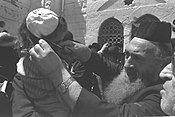First haircut

The first haircut for a human has special significance in certain cultures and religions. It can be considered a rite of passage or a milestone.
Indian
Hindu
In
While complete
Maliku
At the twentieth day from birth,
Mongolian
Mongolian children get their first haircut in early ages between 2–5. Depending on the lunar calendar, boys receive their first hair cut in their odd year and girls in even year. The ritual of cutting the first hair is called Sevleg Urgeeh or Daahi Urgeeh. It is a big occasion for a whole family when guests are invited. Each guest cuts a strand of hair, saying their best wishes to the child, and gives a gift and money.
Orthodox Jew

Many Orthodox and Hasidic Jewish boys get their first haircut when they are three years old. The hair-cutting ceremony is known in Yiddish as the upsherenish or upsherin ("shear off"), and in Hebrew as halaqah (from the Arabic حلاقة - "to shave").
In
Muslim
The
European
Polish
The ritual first haircut (Polish: postrzyżyny) was a pre-Christian pagan-Slavic tradition which survived in Poland well into the 18th century. This first haircut traditionally took place between the ages of 7 and 10, and was conducted by either the boy's father or a stranger, who would thus enter into the boy's family.[6] Before that age the boy's life was connected to his mother and he was treated as a child. The ritual haircut, coupled with the granting of an additional given name (usually the third), marked the boy's coming of age and a transition to the world of men, in which he was to be looked after by his father.[7] The ritual also constituted the father's formal act of recognition of the boy as a son.[7]
Ukrainian
Ukrainian babies often have their hair cut on their first birthday as part of the ancient Postryzhennya custom.[8]
Polynesian
In
Traditionally, Niuean boys do not cut their hair, which is lovingly cared for by sisters, mothers and fathers. When the boys become teenagers, a ceremony is held where women tend the hair for the last time before it is cut. Members of the extended family plaster the youth with banknotes – all part of a large informal Niuean economy that links families and ensures the community looks after its own.[10]
Malaysian
Malaysian children get their first haircut after the mother's confinement period is over, this can be from around 40–44 days long but more recently it has been done in as few as 20 days.[11] After this period is over it is common to invite extended family over for the ceremony of cutting the child's hair. This ceremony is called Cukur Jambul. The purpose of Cukur Jambul is to welcome the new baby into the clan, it also serves the secondary purpose of allowing extended family to renew their relations with each other. After Cukur Jambul has started with a reading from the Quran, the father or mother takes the child to everyone who will cut some of the baby's hair, these people usually include grandparents, members of the marhaban group, local elders, and religious leaders. It is customary for those who do the cutting to gift the baby with something small, like a little cash. The hair is often weighed in order to donate its weight in gold, or the more convenient equivalent, to the poor. It is later put into some sort of bowl and buried in front of close family members in order to finish the ceremony.[12]
North American
Native American
Some Native American tribes commemorated the first haircut with a ritualistic dance. The Apache tribe had a springtime ritual.
African Caribbean
Within the African Caribbean community this is performed once the child begins to speak clearly or after the child reaches two. This is usually done in a barbershop or carried out by the parent.
Yazidi
In the
See also
- Tonsure, traditional practice of Christian churches of cutting or shaving the hair from the scalp (while leaving some parts uncut) of clerics, monastics, and, in the Eastern Orthodox Church, all baptized members.
References
- ^ PMID 28761257.
- ^ a b It is believed to wash away bad karma and give the recipient good karma and a better life than their previous life, from Hindu Council UK web page on the mundan ceremony
- ISSN 0261-3077. Retrieved 2023-05-09.
- PMID 15557039.
- ^ a b The Rights of the New Born Baby in Islam
- ISBN 8321404995.
- ^ Państwowe Wydawnictwo Naukowe. p. 303. PB 1008/63.
- ^ Postryzhennya – The Haircutting Archived 2005-12-17 at the Wayback Machine there are doubts on the reliability of the source
- ^ Cook Islanders – Haircutting ceremony, Porirua – Te Ara Encyclopedia of New Zealand
- ^ Niueans – A young Niuean at his hair-cutting ceremony – Te Ara Encyclopedia of New Zealand
- ^ "Children customary clothe in Malay head shaving - cukur jambul ceremony for the communal". ResearchGate. Retrieved 2020-11-21.
- ISSN 2352-6181.
